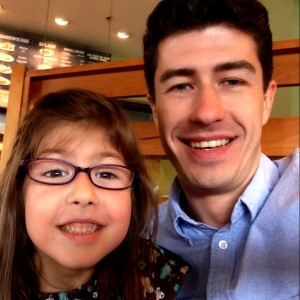Nine years ago, Avalie was born. My first kiddo.
She had already had a number of procedures in the womb to address the cyst growing in her chest and neck. An emergency C-section eight weeks early brought her into a world of tubes, ventilators, needles and an entire staff of amazing nurses and doctors trying everything to keep a baby girl alive.
I was two years into my first professional design job, designing websites and collateral for a small team. Living 40 minutes away from the hospital, each day I would wake up early, head up to the hospital to check in on Avalie, trek down to the office and then after work head back to say goodnight to my daughter.
A few times a week, I’d get the call or text from the staff or my wife that I “better get to the hospital quick.” Avalie had died or nearly died. She had powerful ventilators forcing her lungs to stay open and medicine to paralyze her so that she wouldn’t fight the help of the vent. She also was trached and filled with g-tubes, attended by a brilliant team trying to figure out how to get the cyst to stop filling up with lymph fluid and crushing her lungs.
Two months in, we had a decision to make: hospice or a risky surgery? It was a surgery that the pediatric surgeon said he didn’t want to do, but “if we are at this point, let’s try.” A guess of her chances … 2 percent she makes it through the surgery. Less than 2 percent that she goes on to have a normal life.
The surgery went well, but there was a long road ahead. Still struggling to breathe even with the help of the vent, fighting the fluid in the cyst, she grew, and gradually the fluid slowed. Months later, we moved our then six-month-old out of the neonatal intensive care unit downstairs to the pediatric ICU and start preparing to take her home alive.
I was never at work.
My amazing boss continued to pay me, although for the majority of six months, I wasn’t there.
“Why don’t I set up shop as a freelance contractor and you can send me work?” “Perfect!” And it was official; I had just quit my job while my daughter struggled for life in the hospital. Good idea, right?
My first laptop was opened up in a hospital room. The University of Kansas Medical Center’s Internet was blazing fast compared to home. One of my first clients was an entrepreneur with an idea and a willingness to work with an up-and-coming Kansas City designer to create his new app. I was hooked. Designing interfaces for new ideas. How cool is that!?
So it was official: I was an entrepreneur.
So many years brainstorming ideas, starting clubs, doing side projects. Now it’s real. People depended on me to deliver on my commitments. And I depended on them to find value in it enough to pay me. My life and my family’s lives depended on me finding people actually willing to pay for my skills and services.
I learned so much in those first two years: how to manage time; how to network; how to manage expenses; how to stay up all night to get the job done; and how to be a very busy new dad. Not doing it wasn’t an option. My daughter was fighting for her life, and I was fighting to learn how to work for myself.
Avalie came home at seven-months-old. She was still with a trach, a home ventilator and lots of tubes, but she was alive and home. My wife and I had had a joke that we might think about having more kids if Avalie ever came off the vent. Little girl number two, Emmie, joined us nine months after Avalie said goodbye to the ventilator.
Failure was not an option.
But why would I think about failure? I was having a blast.
I began to connect to the entrepreneur community growing in Kansas City and the work flooded in. Finally, I was ready to take it to the next level. I joined forces with my best friend, Daniel Linhart, and with his operations and business mind and my creative background, we created Cremalab. Dan, our first employee and I all had families. This was no longer a fun experiment. Our wives and kids expected us to make it.
Learning to turn it off.
Owning a growing company demands a lot of work and ton of thinking. Are we doing it right? Will the client pay? Will I make payroll? What’s next for us? How do we launch a new product in a new market that I know very little about? Are our clients happy? Is my team happy? My mind is always going. I may not be designing or writing or collaborating, but I’m always thinking. I’m always considering the possible paths ahead.
I’ve set some guidelines for myself.
- Take the kids to school.
- Work 9 a.m. – 5:30 p.m.(ish).
- Be home by 6 p.m. and be present with the family for dinner and bedtime.
- Don’t work. Don’t look at my phone. Don’t take calls.
- Go back to work after my wife is asleep if needed.
That being said, turning it off is hard. Even after a 45-minute commute, my brain is still cranking. My wife (who also works) wants my attention to help with the family and to show her love. My kids want to play and to know that I think the world of them.
Somewhere in the back of my mind, it’s still cranking. Learning to mute or or turn it off has taken years. Some days are better than others, but I’ve learned how to at least turn down the volume and truly enjoy that time with them.
A few tips to make it worth it!
- Find your identity in something bigger. If you succeed or fail, don’t let who you are be wrapped up 100 percent in what you do. For me it’s my faith. No number of screw ups or wild successes can change that my savior loved me enough to die for me.
- Rest. At least occasionally, get a VERY good night’s sleep. Take at least one day a week and rest. Do as little as possible, even if you enjoy what you do. Just force yourself to turn it off. You’ll love it even more when you come back.
- Spend time with your spouse. Being an entrepreneur may seem really hard to you some days. You being an entrepreneur is DEFINITELY hard for them. Turn it off and love them. Your kids will see that and will think even more of you. I want my kids to know that I love God. I love my wife. I love them. I love my team. I love my clients. I love my city. Pretty close to that order.
- Always be replacing yourself. Find ways to hire people that are smarter than you and that you can trust to do what you’re doing today, so that you can focus on what’s next. Best advice I ever received.
Cremalab is a “Family of Families”
Cremalab has become a family of families. We believe that our team ought to be in a place where they can flourish. This means setting realistic expectations for the amount of hours really needed to hit our outcomes. This means providing an environment where we can work when and where we need to in order to achieve results. Sometimes this means after picking up or dropping off our kids at home.
I now have three amazing little girls. Avalie is eight years old, and unless you saw the scars, you’d have no idea that she had such a rocky start. But her rocky start led to an amazing little girl, and an awesome team launching new businesses and products here at Cremalab
George Brooks is co-founder of Cremalab, a company that specializes in user interface design. Cremalab designs and builds websites and mobile applications for startups and evolving brands. Follow him on Twitter @conceptsguy.





